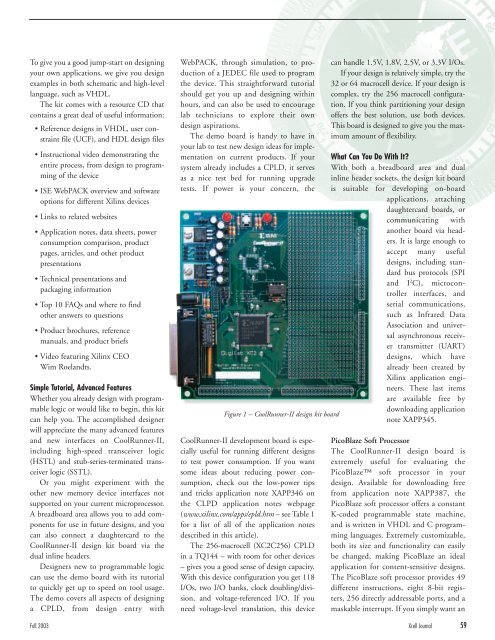Discover New Applications For Low-Cost Solutions Discover ... - Xilinx
Discover New Applications For Low-Cost Solutions Discover ... - Xilinx
Discover New Applications For Low-Cost Solutions Discover ... - Xilinx
You also want an ePaper? Increase the reach of your titles
YUMPU automatically turns print PDFs into web optimized ePapers that Google loves.
To give you a good jump-start on designing<br />
your own applications, we give you design<br />
examples in both schematic and high-level<br />
language, such as VHDL.<br />
The kit comes with a resource CD that<br />
contains a great deal of useful information:<br />
• Reference designs in VHDL, user constraint<br />
file (UCF), and HDL design files<br />
• Instructional video demonstrating the<br />
entire process, from design to programming<br />
of the device<br />
• ISE WebPACK overview and software<br />
options for different <strong>Xilinx</strong> devices<br />
• Links to related websites<br />
• Application notes, data sheets, power<br />
consumption comparison, product<br />
pages, articles, and other product<br />
presentations<br />
• Technical presentations and<br />
packaging information<br />
• Top 10 FAQs and where to find<br />
other answers to questions<br />
• Product brochures, reference<br />
manuals, and product briefs<br />
• Video featuring <strong>Xilinx</strong> CEO<br />
Wim Roelandts.<br />
Simple Tutorial, Advanced Features<br />
Whether you already design with programmable<br />
logic or would like to begin, this kit<br />
can help you. The accomplished designer<br />
will appreciate the many advanced features<br />
and new interfaces on CoolRunner-II,<br />
including high-speed transceiver logic<br />
(HSTL) and stub-series-terminated transceiver<br />
logic (SSTL).<br />
Or you might experiment with the<br />
other new memory device interfaces not<br />
supported on your current microprocessor.<br />
A breadboard area allows you to add components<br />
for use in future designs, and you<br />
can also connect a daughtercard to the<br />
CoolRunner-II design kit board via the<br />
dual inline headers.<br />
Designers new to programmable logic<br />
can use the demo board with its tutorial<br />
to quickly get up to speed on tool usage.<br />
The demo covers all aspects of designing<br />
a CPLD, from design entry with<br />
WebPACK, through simulation, to production<br />
of a JEDEC file used to program<br />
the device. This straightforward tutorial<br />
should get you up and designing within<br />
hours, and can also be used to encourage<br />
lab technicians to explore their own<br />
design aspirations.<br />
The demo board is handy to have in<br />
your lab to test new design ideas for implementation<br />
on current products. If your<br />
system already includes a CPLD, it serves<br />
as a nice test bed for running upgrade<br />
tests. If power is your concern, the<br />
Figure 1 – CoolRunner-II design kit board<br />
CoolRunner-II development board is especially<br />
useful for running different designs<br />
to test power consumption. If you want<br />
some ideas about reducing power consumption,<br />
check out the low-power tips<br />
and tricks application note XAPP346 on<br />
the CLPD application notes webpage<br />
(www.xilinx.com/apps/epld.htm – see Table 1<br />
for a list of all of the application notes<br />
described in this article).<br />
The 256-macrocell (XC2C256) CPLD<br />
in a TQ144 – with room for other devices<br />
– gives you a good sense of design capacity.<br />
With this device configuration you get 118<br />
I/Os, two I/O banks, clock doubling/division,<br />
and voltage-referenced I/O. If you<br />
need voltage-level translation, this device<br />
can handle 1.5V, 1.8V, 2.5V, or 3.3V I/Os.<br />
If your design is relatively simple, try the<br />
32 or 64 macrocell device. If your design is<br />
complex, try the 256 macrocell configuration.<br />
If you think partitioning your design<br />
offers the best solution, use both devices.<br />
This board is designed to give you the maximum<br />
amount of flexibility.<br />
What Can You Do With It?<br />
With both a breadboard area and dual<br />
inline header sockets, the design kit board<br />
is suitable for developing on-board<br />
applications, attaching<br />
daughtercard boards, or<br />
communicating with<br />
another board via headers.<br />
It is large enough to<br />
accept many useful<br />
designs, including standard<br />
bus protocols (SPI<br />
and I2C), microcontroller<br />
interfaces, and<br />
serial communications,<br />
such as Infrared Data<br />
Association and universal<br />
asynchronous receiver<br />
transmitter (UART)<br />
designs, which have<br />
already been created by<br />
<strong>Xilinx</strong> application engineers.<br />
These last items<br />
are available free by<br />
downloading application<br />
note XAPP345.<br />
PicoBlaze Soft Processor<br />
The CoolRunner-II design board is<br />
extremely useful for evaluating the<br />
PicoBlaze soft processor in your<br />
design. Available for downloading free<br />
from application note XAPP387, the<br />
PicoBlaze soft processor offers a constant<br />
K-coded programmable state machine,<br />
and is written in VHDL and C programming<br />
languages. Extremely customizable,<br />
both its size and functionality can easily<br />
be changed, making PicoBlaze an ideal<br />
application for content-sensitive designs.<br />
The PicoBlaze soft processor provides 49<br />
different instructions, eight 8-bit registers,<br />
256 directly addressable ports, and a<br />
maskable interrupt. If you simply want an<br />
Fall 2003 Xcell Journal 59

















